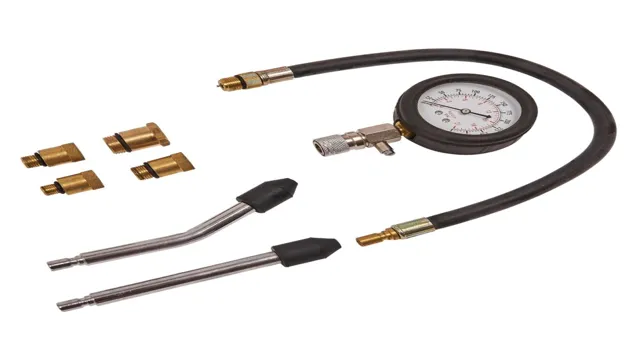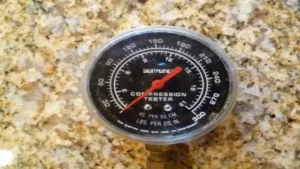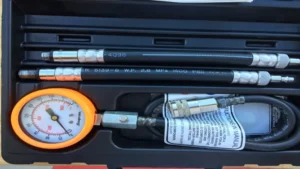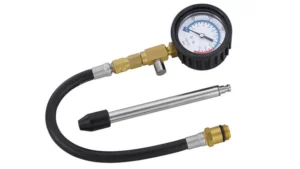If you’re a car owner or a mechanic, then you know how important it is to maintain your engine’s performance. One key tool that you should always have in your arsenal is a compression tester. But, what exactly is a compression tester and why is it such an essential tool? In simple terms, a compression tester is a device that measures the compression pressure inside an engine cylinder.
It tells you whether your engine’s cylinders are producing enough pressure to ignite the fuel-air mixture and power the engine. It can also help diagnose engine problems like leaking valves or worn pistons. So, why should you bother with a compression tester? Well, it can save you time, money, and headaches in the long run by helping you diagnose and fix engine problems before they become bigger issues.
The compression tester is a must-have tool for anyone who wants to keep their engine running smoothly and avoid costly repairs.
Understanding Engine Compression
A compression tester is a diagnostic tool used to measure the engine’s compression pressure and identify any issues related to the engine’s performance. It is a simple and effective way to determine the engine’s health and identify any potential problems before they become major issues. A compression tester can help you diagnose a range of engine problems such as worn-out or damaged piston rings, faulty valves or valve seats, and even head gasket leaks.
This tool is easy to use and can provide you with accurate readings in just a few minutes. By performing regular compression tests, you can ensure that your engine is running smoothly and efficiently, prevent major problems from developing, and save yourself from costly repairs in the future. Overall, a compression tester is an essential tool for any car owner or mechanic to have in their toolbox.
What Causes Low Compression
Low compression in an engine can be caused by a variety of factors. The most common cause is worn or damaged piston rings, which allow air and fuel to escape from the combustion chamber and reduce compression. Another common cause is a blown head gasket, which can cause compression loss between cylinders or between the combustion chamber and coolant passages.
Other possible causes include worn valve seats or valves, a cracked cylinder head or block, or incorrect valve timing. Understanding the causes of low compression can help prevent and diagnose engine problems, and ensure that your engine is running at optimal performance. Regular maintenance and inspections are important for identifying and addressing issues before they result in serious damage.
By taking care of your engine and addressing issues promptly, you can extend the life of your vehicle and prevent costly repairs down the road.
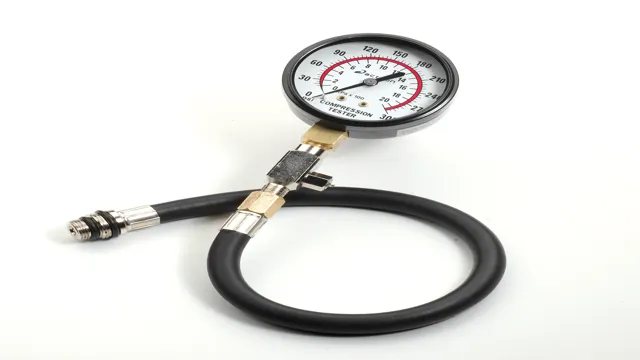
Why Compression Test is Important
Engine compression is a crucial aspect of maintaining the overall health of your vehicle’s engine. Essentially, compression refers to the pressure generated within the engine’s combustion chamber when the fuel-air mixture is ignited. Measuring this pressure is essential in detecting any issues with the engine’s performance, such as worn-out piston rings or leaking valves.
A compression test is performed to assess the health of the engine, and it involves connecting a compression gauge to the spark plug hole and measuring the pressure generated during the combustion process. If the pressure readings are low, it could indicate potential issues that require immediate attention, such as a blown head gasket or worn-out piston rings. In contrast, if the readings are within the recommended range, it’s an indication that the engine is healthy and performing optimally.
Therefore, it’s essential to perform a compression test regularly to identify and resolve problems before they become more significant and potentially cause engine failure.
How to Perform a Compression Test
A compression tester is a tool used to measure the engine’s ability to generate adequate compression. This test is essential in determining the health of the engine and identifying problems that could require repairs. A low compression reading often indicates cylinder wear, piston ring damage, or other engine issues.
To perform a compression test, you will need to have a compression tester and a set of instructions for your specific vehicle. First, you will remove the fuel pump fuse, and then connect the compression tester to the spark plug hole. After that, you will turn the engine over a few times and take a reading in each cylinder.
The recommended PSI (pounds per square inch) for each engine varies depending on the make and model of the vehicle. Once you have completed the test, you can identify any problems and determine the necessary repairs. A compression tester is an invaluable tool for maintaining your vehicle’s performance and ensuring its long-term health.
Required Tools and Equipment
Performing a compression test is a critical step in determining the engine’s health and performance. To perform this test, you need several tools and equipment, including a compression gauge, a spark plug wrench, and a proper socket set to remove spark plugs. The first step is to warm up the engine to its normal operating temperature before turning it off.
Then, detach the spark plugs from the engine block. Next, attach the compression gauge to the spark plug hole, and crank the engine over for around five seconds to generate the necessary compression readings. Repeat the test for all cylinders, and compare readings to manufacturer specifications to determine if any of the cylinders are experiencing any compression-related issues.
A compression test can be an efficient and reliable way to diagnose engine problems and prevent future damage.
Step by Step Guide
Performing a compression test is an essential part of maintaining your car’s engine and ensuring it performs at its best. It involves checking the cylinders for an adequate compression level. To start, you’ll need to open the hood and locate the spark plugs.
Then, remove each spark plug and attach a compression tester to the first cylinder. Have a helper turn the engine over, and note the reading on the tester. Repeat this process for each cylinder.
If the readings are within 10% of each other, your engine is considered healthy. However, if there is a significant variation, it could indicate a problem, such as worn rings or valves. By performing a compression test regularly, you can catch any issues before they cause serious damage to your engine.
So next time you need to take care of your engine, don’t forget to perform a compression test. It will save you time and money in the long run.
Interpreting Compression Test Results
A compression tester is a tool used to measure the compression levels inside an engine’s cylinders. This measurement can indicate the health and performance of the engine. To use a compression tester, you must first remove the spark plugs from the engine, then screw in the tester’s adapter.
Next, you must disable the fuel and ignition systems before cranking the engine a few times to allow the pressure to build up inside the cylinders. Once this is done, you can read the results on the tool’s gauge. Typically, the compression levels should be around 100 psi to 200 psi, depending on the engine type.
If the results are outside of this range, it could indicate a variety of problems, including worn piston rings, cylinder wall damage, head gasket failures, and more. It is essential to interpret the results correctly and, if needed, seek professional help to ensure the engine’s longevity. Overall, a compression tester is a valuable tool for diagnosing engine issues and maintaining the engine’s overall health, making it an essential tool for mechanics and DIY enthusiasts alike.
What is Normal Compression
Compression testing is a common method used in the automotive and engineering industries to measure a material’s strength and elasticity. Normal compression refers to the maximum amount of pressure a material can withstand before it deforms or breaks. This is an important measurement as it helps manufacturers and engineers understand a material’s suitability for specific applications.
Interpreting compression test results involves understanding various factors such as the shape and size of the sample, the testing method used, and any external factors that may affect the results. By analyzing compression test results, manufacturers and engineers can optimize the performance and durability of their products. Understanding normal compression is crucial for ensuring the safety and reliability of different components and structures, from car engines to building foundations.
What does Low Compression Mean
Low compression is a vital term to comprehend when it comes to engine health. It determines the amount of resistance an engine’s pistons face when compressing air and fuel. Generally, low compression readings suggest that the engine’s internal components have experienced wear or damage, reducing its overall performance.
However, this doesn’t provide a definitive diagnosis of the issue. Instead, other factors such as timing, valve conditions, or head gasket integrity may cause low compression levels. A qualified mechanic can help diagnose the issue using specialized tools and techniques, such as performing a leak-down test, and offer repairs to get your engine performing as it should.
Understanding and interpreting compression test results helps vehicle owners maintain engine health, ensuring a longer-lasting and more reliable vehicle.
Conclusion
A compression tester is the superhero of automotive maintenance. With the power to detect the internal health of an engine, it saves mechanics from hours of frustrating guesswork and prevents catastrophic engine failures. It’s like having x-ray vision for your car’s vital organs.
So, if you want to keep your vehicle running smoothly, make sure you’ve got your compression tester in hand, ready to leap into action at a moment’s notice.”
FAQs
What is a compression tester used for?
A compression tester is a tool that is used to measure the compression pressure inside of an engine cylinder. It is used to diagnose potential engine problems such as low compression, misfires, and engine performance issues.
How do you use a compression tester?
To use a compression tester, first remove the spark plug from the cylinder that you want to test. Then, screw the compression tester into the spark plug hole and turn the engine over a few times. The gauge on the compression tester will show the amount of compression pressure in the cylinder.
Is a compression test necessary before buying a used car?
Yes, a compression test is recommended before buying a used car. It can help identify any engine issues that may not be immediately apparent, and could save you from costly repairs down the line.
What is considered good compression?
Good compression is generally considered to be between 135psi and 170psi. However, the optimal compression level can vary depending on the make and model of the engine.
Can a compression test help determine the health of an engine?
Yes, a compression test can provide valuable information about the health of an engine. Low compression readings can indicate a variety of engine problems, such as worn piston rings, damaged valves, or a blown head gasket.
Can a compression test be done on any engine?
No, not all engines can be tested using a compression tester. Some engines, such as rotary engines, do not have a traditional cylinder design and require different testing methods.
How often should you perform a compression test?
Compression tests aren’t usually required as part of routine maintenance, but doing one every few years can help catch any engine problems before they become major issues. They should also be performed if you notice any changes in your engine’s performance.
